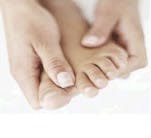Anodyne Therapy: A Photo-Energy Treatment Modality
Geriatric Gait and Balance Outcomes Study
This study involving 38 inpatients was published in Journal of Geriatric Physical Therapy, April 2004.
Physical therapy in combination with Anodyne was able to:
- Significantly improve Tinetti scores, a measure of gait and balance, from an average of "high fall risk" to an average of "moderate fall risk" - with a 93% improvement in Tinetti scores.
- Reduce falls from total of 98 in the 90 days pre-therapy to total of 4 in the 90 days post-therapy.

Pre-treatment Tinetti scores averaged 11, with all but 2 patients at "high fall risk." Most patients in this category need to use assistive devices to prevent falling. Ten patients started at a score of 5, most needing a wheelchair, unable to stand without assistance.
Post-treatment scores showed 70% of "high fall risk" patients moved to a lower fall risk category. The average Tinetti score improved by 93% - a change unheard of in patients with poor proprioception. All but one of the patients starting with a score of 5 had significant improvements, dropping to "moderate fall risk."
Actual fall rates improved 96% post-treatment.
The study protocol was as follows:
- Anodyne protocol: 30 minute sessions, 5 times per week; 5 to 20 sessions, with a mean of 12.5
- Combined with physical therapy
Tinetti score key: <19 = High Fall Risk, 19 to 24 = Moderate Fall Risk, 25-27 = Low Fall Risk, 28 = Normal
[Note: Anodyne is not cleared for improving gait and balance or fall rates. In these outcomes, Anodyne therapy was used adjunctively to increase circulation and reduce pain as part of a coordinated physical therapy plan. The gait, balance and falls results cannot be ascribed to Anodyne therapy alone.]
Gait/Balance Outcomes (Tinetti Score)
This study of 272 patients was published in Physical and Occupational Therapy in March 2006. The study included all patients treated during the prior 90 days, including treatment failures. The Anodyne protocol used: mean of 34 minute treatment sessions, for a total of 18 treatments.
Tinetti Scores
Diabetic patients averaged Tinetti of 14.2 (High Fall Risk) pre-Anodyne therapy. Following Anodyne, this average went down to 23.2 (Moderate Fall Risk - bordering on Low Risk which is measured at > 24), a 63% improvement In non-diabetic patients, average Pre-Anodyne Tinetti scores were 12.9 (High Fall Risk). Following Anodyne, their average dropped to 23.4 (Moderate Fall Risk - bordering on Low Risk which is measured at > 24), a 81% improvement.
At the beginning of the study, 220 of the 272 total patients (81%) had a Tinetti score below 19. After Anodyne treatment, only 9% remained in the High Fall Risk category.
Tinetti score key: <19 = High Fall Risk, 19 to 24 = Moderate Fall Risk, 25-27 = Low Fall Risk, 28 = Normal
Pain Scores
- Pain score average -- all patients (272 patients)
- Pre-MIRE therapy - 7.7
- Post-MIRE therapy - 4.8
- = 38% improvement - All patients
- Pain score average -- patients with pain > 8.5 (horrible to excruciating) (37 patients)
- Pre-Mire therapy - 9.4
- Post-MIRE therapy - 4.8
- = 49% improvement in Horrible to Excruciating Pain
- The pain reduction on a 10 point VAS was statistically significant in all patients, including those who had excruciating pain over a level of 8.5 out of 10.
[Note: Anodyne is not cleared for improving gait and balance. These outcomes used Anodyne to increase circulation and reduce pain. The gait, balance and falls results cannot be ascribed to Anodyne therapy alone.]
